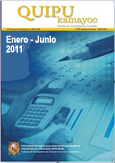BLENDED LEARNING: POSSIBILITIES APPLICATION IN THE TECHNOLOGICAL UNIVERSITY OF CANCUN
DOI:
https://doi.org/10.15381/quipu.v18i35.3841Keywords:
Formación de capital humano, aprendizaje combinado, Tecnologías de la Información y Comunicaciones.Abstract
At present the present time the skill related to the Technologies of Information and Communication (TIC´s) acquiere every day more importance in the contribution to business success, mainly in the area of formation of human capital, in which in-line education trends. For this reason, the universities must begin to implement education model in-line learning, combined with the actual clases, with the objective that the students acquire experience in the use of the TIC´s. In consecuence, the present investigaction provides an approach to the model of b-learning to explain what elements are included and the studen and teacher`s roll, as well as to Know the possibilities for its implementation and identifying, initially, if we count with the necessary resources, means, knowledge and interest in the use of the TIC´s in the processes of an already realised study of eduction and student of Business Administration of the Divisiñon Económico administrativa of the Universidad Tecnológica de Cancún. And finally to reach conclusions and recommendations for its application.
Downloads
Downloads
Published
Issue
Section
License
Copyright (c) 2011 Antonio Pérez De la Cruz

This work is licensed under a Creative Commons Attribution-NonCommercial-ShareAlike 4.0 International License.
AUTHORS RETAIN THEIR RIGHTS:
a. Authors retain their trade mark rights and patent, and also on any process or procedure described in the article.
b. Authors retain their right to share, copy, distribute, perform and publicly communicate their article (eg, to place their article in an institutional repository or publish it in a book), with an acknowledgment of its initial publication in Quipukamayoc .
c. Authors retain theirs right to make a subsequent publication of their work, to use the article or any part thereof (eg a compilation of his papers, lecture notes, thesis, or a book), always indicating the source of publication (the originator of the work, journal, volume, number and date).






